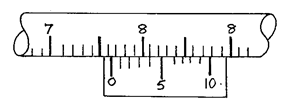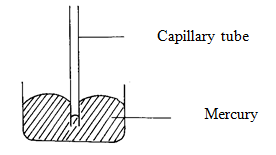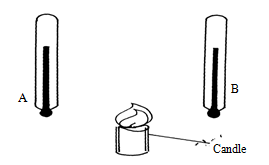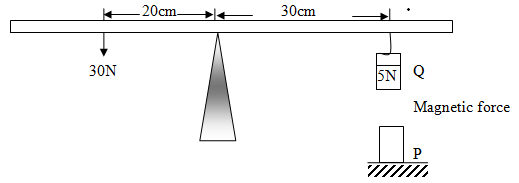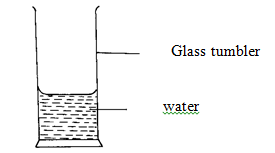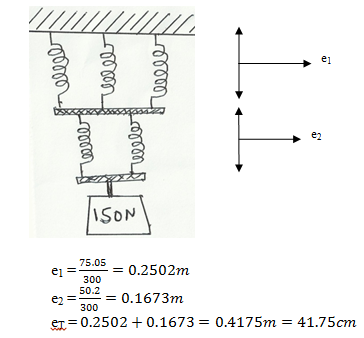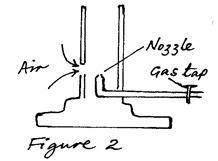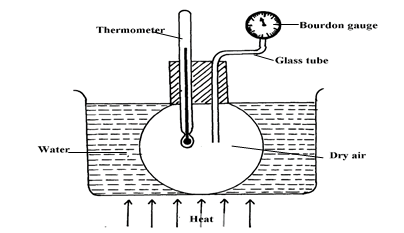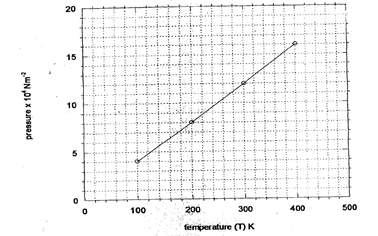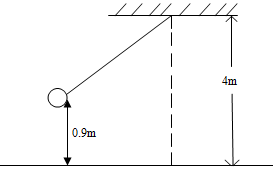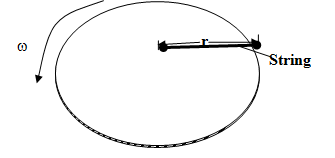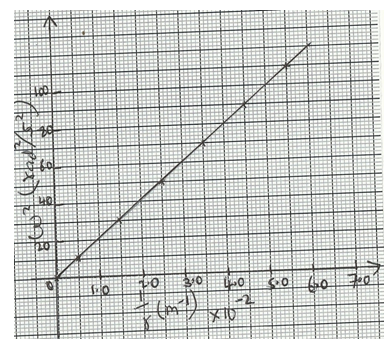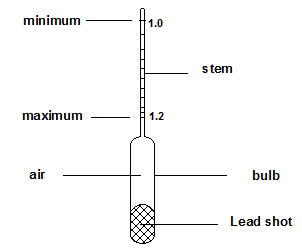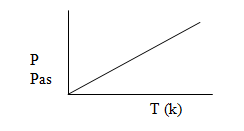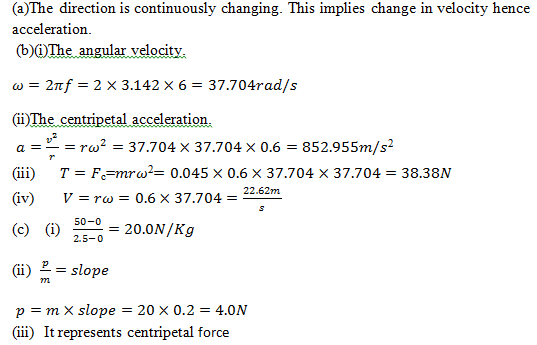SECTION 1
Answer all questions in the spaces provided
- The figure below shows a vernier calipers scale
State the correct reading of scale if the instrument has a zero-error of -0.02cm (2 mks) - The diagram below shows the behaviour of mercury in a capillary tube.
Explain the behaviour (2mks)
- In an experiment to estimate the size of a molecule of olive oil, a drop of oil of volume 0.12cm3 was placed on a clean water surface. The oil spread on a patch of diameter 6.0 x 106 mm2.
- Calculate the size of the molecule 3mks
- State an assumption made in the above calculations. 1mk
- The figure below shows a clinical thermometer.
State the function of the constriction. 1mk
- The figure below shows two identical thermometers. Thermometer A has a blackened bulb while thermometer B has a silvery bulb. A candle is placed equidistant between the two thermometers
State with a reason the observations made after some time (2mark) - A uniform metre rule is balanced at its centre. It is balanced by the 30N, 5N and the magnetic force between P and Q. P is fixed and Q has a weight of 5N
Ignoring the weight of the metre rule, calculate the value of the magnetic force between Q and P 2mks
- The pattern below shows oil leakage on a path at the rate of 10drops per second form a lorry.
Calculate the acceleration of the lorry (3mks)
- The figure below shows a glass tumbler partly filled with water at room temperature.
Briefly explain what happens to the stability of the tumbler when water is cooled to temperatures below 00C. 1mk
- The spiral springs shows in the figure below are identical. Each spring has a spring constant K = 300N/m .Each rod weighs 0.1N and each spring weighs 0.2N.
- Determine the total extension caused by the 150N weight. (2marks)
- Apart from length of the spring and nature of material, state one other factor affecting the spring constant. (1mark)
- A car is brought to rest from a speed of 30m/s in 2 seconds. If the driver’s reaction time is 0.3s, determine the shortest stopping distance. 3mks
- The figure below shows a Bunsen burner.
Use the Bernoulli’s Principle to explain how air is drawn into the burner when the gas tap opened. 2mks
SECTION II (55 marks)
-
-
- Define Archimedes’s Principle. (1 mark)
- An object weighs 1.04N in air, 0.64N when fully immersed in water and 0.72N when fully immersed in a liquid. If the density of water is 1000 kgm-3, find the density of the liquid. (3 marks)
-
- Define the law of floatation (1 mark)
- Give a reason why a steel rod sinks in water while a ship made of steel floats on water. (1 mark)
- Draw a clearly labelled diagram of a common hydrometer which is suitable for measuring the densities of liquids varying between 1.0 and 1.2 g cm-3.(2 mks)
- The figure below shows a buoy, B, of volume 40 litres and mass 10 kg. It is held in position in sea water of density 1.04 g cm-3 by a light cable fixed to the bottom so that of the volume of the buoy is below the surface of the sea water.
Determine the tension T in the cable. (2 marks)
-
- The figure below shows a simple set up for pressure law apparatus:
- Describe how the apparatus may be used to verify pressure law (2 marks)
- The graph in the figure below shows the relationship between the pressure and temperature for a fixed mass of an ideal gas at constant volume
- Given that the relationship between pressure, P and temperature, T in Kelvin is of the form P = kT + C Where k and C are constants, determine from the graph, values of k and C (2 marks)
- Why would it be possible for pressure of the gas to be reduced to zero in practice? (1 mark)
- A gas is put into a container of fixed volume at a pressure of 2.1 x 105. Nm-2 and temperature 27°C. The gas is then heated to a temperature of 327°C. Determine the new pressure (2 marks)
-
- An electric crane lifts a load of 2000kg through a vertical distance of 3.0m in 6s.
Determine:- Work done (1mk)
- Power developed by the crane (2mks)
- Efficiency of the crane if it is operated by an electric motor rated 12.5 Kw.(2mks)
- A bob of mass 20kg is suspended using a string of 4m from a support and swings through a vertical height of 0.9m as shown below:
Determine:- The potential energy of the body at this position. (2mks)
- Speed of the body when passing through the lowest point. (2mks)
- An electric crane lifts a load of 2000kg through a vertical distance of 3.0m in 6s.
-
- The moon goes round the earth at constant speed. Explain why it is true to say that the moon is accelerating. (1 mark)
- A string of negligible mass has a bucket tied at the end. The string is 60cm long and the buckets has a mass of 45g. The bucket is swung horizontally making 6 revolutions per second.
Calculate:- the angular velocity. (1 mark)
- the centripetal acceleration. (2 marks)
- the tension on the string. (2 marks)
- the linear velocity. (1 mark)
- The figure below shows a body of mass; attached to the centre of a rotating table with a string. The radius of the string was varied and different values of angular velocity recorded.
The mass of the body remained constant throughout the experiment. The results obtained for angular velocity and radius were used to plot the following graph;
From the above graph;- Calculate the value of the slope. (2marks)
- If ω2 and 1/r are related by the equation;ω2 = p/r × 1/m , find the value of P. (2marks)
- State the significance of P. (1mark)
-
- Define the term specific heat capacity. (1 mark)
- A block of metal of mass 150g at 100°C is dropped into a lagged calorimeter of heat capacity 40Jk-1 containing 100g of water at 25° The temperature of the resulting mixture is 34°C. (Specific heat capacity of water = 4200Jkgˉ¹).
Determine;- Heat gained by calorimeter. (2 marks)
- Heat gained by water. (2 marks)
- Heat lost by the metal block. (1 mark)
- Specific heat capacity of the metal block. (2 marks)
- State two differences between boiling and evaporation. (2mark)
-
-
- State Newton’s second law of motion. (1 mark)
- A striker kicks a ball of mass 250g initially at rest with a force of 75N. if the foot was in contact with the ball for 0.10sec. Calculate the take-off velocity of the ball. (2 marks)
- A bullet of mass 20g moving at 400 m/s strikes a block of wood of mass 3.5kg initially at rest. The bullet sticks into the block and the two move off together on a horizontal surface, where a frictional retarding force of 4N is acting between the block and surface.
- Determine the initial common velocity of bullet and wooden block. (2marks)
- What distance does the block move before coming to rest? (2marks)
-

MARKING SCHEME
- 7.6 + ( 0.01 x 4)
7.6 + (0.01 x 4)
= 7.64 cm
Correct reading = 7.64 + 0.02
= 7.66 cm
- -Cohension between mercury molecules is greater than adhesion between mercury and glass;
- The mercury sinks down the tube to enable molecules to keep together ;
-
- v = At ;
t = v = 0.12cm
A
= 6 x 106 x 10-3 ;
= 2 x 10-5 cm or 2 x 10-7m ;
- v = At ;
-
-
- Thickness of the drop is equal to size of a molecule ;
- The oil drop spread uniformly into a circular path
- Prevents the column of mercury beyond the constriction from going back to the mercury bulb hence allowing reading at one’s own convenience ;
Can painted black ; it is a better absorber of radiant heat ;
-
- Σ ACM = Σcm
30 x 20 = 30 x F
F = 20N
Magnetic force = 20-5
= 15N - F=0.1HZ
U = 4/0.2 = 5m/s
V = 0.5/0.2 = 2.5 m/s
a= -2.5 / 0.6 = -4.167 - Water expands on freezing raising the centre of gravity of the tumbler ;Thus the glass tumbler becomes less stable;
-
-
- The diameter of the spring, number of turns per unit length, thickness of the wire used to make the spring
-
- Before braking, distance = 0.3 x 30= 9m
After braking
S = ut + ½ at2
S= 30 x 2 + ½ (-15) x 22
S= 60 – 30
S = 30m
Total stopping distance = 9 + 30= 39m - As the gas passes through the nozzle, its velocity increases P. Hence its pressure reduces above the nozzle. The higher atmospheric pressure pushes air into the gas stream.
-
-
- Archimede’s Principle staes that when a body is partially or wholly immersed in a fluid, it experiences an upthrust equal to the weight of the fluid desplaced.
- Upthrust in liquid = 1.04 – 0.72 = 0.32N
Upthrust in water = 1.04 – 0.64 = 0.40
-
- A floating body displaces its own weight of the fluid in which it floats.
- A ship is hollow and displaces a large volume of water to provide enough upthrust equal to its own weight, while steel rod sinks since it is denser than water.
- Hydrometer
- Volume of water displced = ¾ x 40 = 30 l = 0.03 m3
Weight of buoy = mg = 10 x 10 = 100N
Weight of sea water displced = density x gravity x volume
= 1.04 x 103 x 10 x 0.03 N = 312N
Weight of sea water displced = Upthrust
Tension T = Upthrust – Weight of buoy = 312 – 100 ; T = 212N
-
-
- Plotting pressure against absolute temp we get a straight line graph
Conclusion
Pressure of infixed mass of a gas indirectly proportional to its absolute to temperature if volume is kept constant -
- P = kT + C Where k and C are constants, determine from the graph, values of k and C
K = gradient
= (8-0) X 104 NM -2
200 - 0
K = 400N m-2 K-1
C = O - Why would it be possible for pressure of the gas to be reduced to zero in practice?
The gas liquefies at low temperature before reaching zero Kelvin
- P = kT + C Where k and C are constants, determine from the graph, values of k and C
- A gas is put into a container of fixed volume at a constant volume at a pressure of 2.1 x 105. Nm-2 and temperature 27°C. The gas is then heated to a temperature of 327°C. Determine the new pressure
P1 = P2
T1 T2
T2 =273 + 327 = 600K
P1 = 2.1 X 105 Nm-2
P2 = P1 T2
T1
P2 = ?
T1= 27+ 273
= (2.1 X 600) X 105NM -2 = 4.2 X105NM-2
300
= 300K
- Plotting pressure against absolute temp we get a straight line graph
-
- Specific heat capacity is the quantity of heat required to raise the temp.of a unit mass of a substance by one Kelvin.
- Heat gained by calorimeter = MCCCDq
= Heat capacity x Dq
= 40 x (34 – 25)
= 40 x 9 = 360J
Heat gained by water = MW x CW x Dq
= 0.10 x 4200 x 9
= 3780J - Heat lost by metal block = 3780 + 360 = 4140J P
- Heat lost by metal block = Heat gained by calorimeter + water
Mb x Cb x Dq = 4140
0.15 x Cb x (100 – 34) = 4140
(66 x 0.15)Cb = 4140 P
-
-
- A body continues in its state of ret or uniform motion in a straight line unless acted upon by an external force.
Ft = m (v-u)
75 x 0.1 =25/1000 (V-0)
V = 30 m/s
- A body continues in its state of ret or uniform motion in a straight line unless acted upon by an external force.
-
- M1V1 + M2V2 = (M1V2)v
V = 2.27 m/s - a =F/m
= -1.136 m/s2
v2 = u2 + 2as
0 = (2.27)2 – (2 x 1.136s)
s = 2.268 m
- M1V1 + M2V2 = (M1V2)v
-
Download PHYSICS PAPER 1 - KCSE 2019 MASENO MOCK EXAMINATION (WITH MARKING SCHEME).
Tap Here to Download for 50/-
Get on WhatsApp for 50/-
Why download?
- ✔ To read offline at any time.
- ✔ To Print at your convenience
- ✔ Share Easily with Friends / Students

